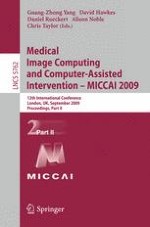2009 | Buch
Medical Image Computing and Computer-Assisted Intervention – MICCAI 2009
12th International Conference, London, UK, September 20-24, 2009, Proceedings, Part II
herausgegeben von: Guang-Zhong Yang, David Hawkes, Daniel Rueckert, Alison Noble, Chris Taylor
Verlag: Springer Berlin Heidelberg
Buchreihe : Lecture Notes in Computer Science
